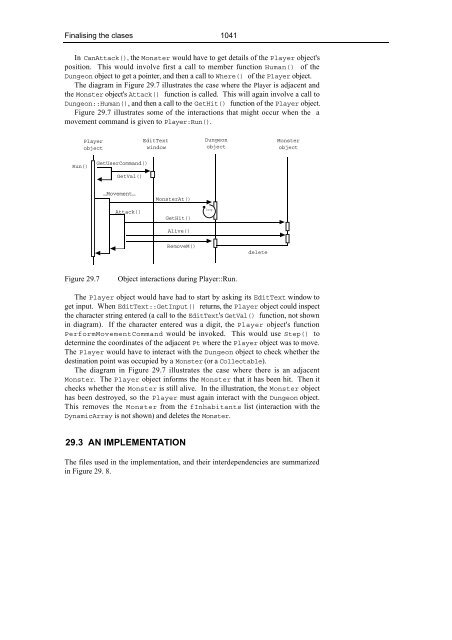29 The Power of Inheritance and Polymorphism
29 The Power of Inheritance and Polymorphism
29 The Power of Inheritance and Polymorphism
You also want an ePaper? Increase the reach of your titles
YUMPU automatically turns print PDFs into web optimized ePapers that Google loves.
Finalising the clases 1041In CanAttack(), the Monster would have to get details <strong>of</strong> the Player object'sposition. This would involve first a call to member function Human() <strong>of</strong> theDungeon object to get a pointer, <strong>and</strong> then a call to Where() <strong>of</strong> the Player object.<strong>The</strong> diagram in Figure <strong>29</strong>.7 illustrates the case where the Player is adjacent <strong>and</strong>the Monster object's Attack() function is called. This will again involve a call toDungeon::Human(), <strong>and</strong> then a call to the GetHit() function <strong>of</strong> the Player object.Figure <strong>29</strong>.7 illustrates some <strong>of</strong> the interactions that might occur when the amovement comm<strong>and</strong> is given to Player:Run().PlayerobjectEditTextwindowDungeonobjectMonsterobjectRun()GetUserComm<strong>and</strong>()GetVal()…Movement…Attack()MonsterAt()GetHit()loopAlive()RemoveM()deleteFigure <strong>29</strong>.7Object interactions during Player::Run.<strong>The</strong> Player object would have had to start by asking its EditText window toget input. When EditText::GetInput() returns, the Player object could inspectthe character string entered (a call to the EditText's GetVal() function, not shownin diagram). If the character entered was a digit, the Player object's functionPerformMovementComm<strong>and</strong> would be invoked. This would use Step() todetermine the coordinates <strong>of</strong> the adjacent Pt where the Player object was to move.<strong>The</strong> Player would have to interact with the Dungeon object to check whether thedestination point was occupied by a Monster (or a Collectable).<strong>The</strong> diagram in Figure <strong>29</strong>.7 illustrates the case where there is an adjacentMonster. <strong>The</strong> Player object informs the Monster that it has been hit. <strong>The</strong>n itchecks whether the Monster is still alive. In the illustration, the Monster objecthas been destroyed, so the Player must again interact with the Dungeon object.This removes the Monster from the fInhabitants list (interaction with theDynamicArray is not shown) <strong>and</strong> deletes the Monster.<strong>29</strong>.3 AN IMPLEMENTATION<strong>The</strong> files used in the implementation, <strong>and</strong> their interdependencies are summarizedin Figure <strong>29</strong>. 8.
















